Opinion by Matt Pedersen
I grew up with the Redtailed Black Shark; back then we knew it was Labeo bicolor but these days we call it Epalzeorhynchos bicolor. I’m sure I owned one before my 10th birthday, which puts the timeframe into the early-mid 1980s.
Only a few years later, when I started working in the retail aquarium trade, Redtailed Sharks would be routine orders to stock the freshwater offerings. While I continued to purchase and sell Redtailed Black Sharks, I was completely unaware to their plight in the wild. By 1996, the IUCN had declared the species extinct in the wild, but in a time before the Internet, such news never even made it to aquariums shops like the one where I was working.
Then, and still today, the Redtailed Black Shark remains in steady supply, available for the aquarium hobbyist to purchase, despite spending the next 15 years being considered”extinct in the wild.” Yes, through 2011, any aquarist could walk into any freshwater aquarium shop, probably even their local Walmart, and buy an animal that was considered “extinct.” In fact, on the surface of things, nothing changed in 2011 other than the recognition of a small population of Redtailed Sharks hanging on in Thailand’s Chao Phraya basin, in an area the IUCN suggests is “less than 10 km².” This information obviously forced the IUCN to recategorize the species as “critically endangered.” Meanwhile, the trade in the species continued, uninterrupted, for one simple reason—massive commercial-scale aquaculture production.
The recently published discovery of a single wild specimen of E. bicolor in new area has aquarists buzzing with excitement for the species. The news spurred me to think again about this species, emblematic of what I believe is “right” with the aquarium trade, and it perhaps revealed a larger picture that overshadows this good news with a more unsettling reality.
The Endangered Species Act
These days, with the some livestock in marine aquarium trade under threat from proposed Endangered Species Act (ESA) listings ranging from widespread coral proposals to bread-and-butter fish species such as the Banggai Cardinalfish (Pterapogon kauderni), Green Chromis (Chromis viridis), or Percula Clownfish (Amphiprion percula), it leaves me with a troubling question about trade regulation.
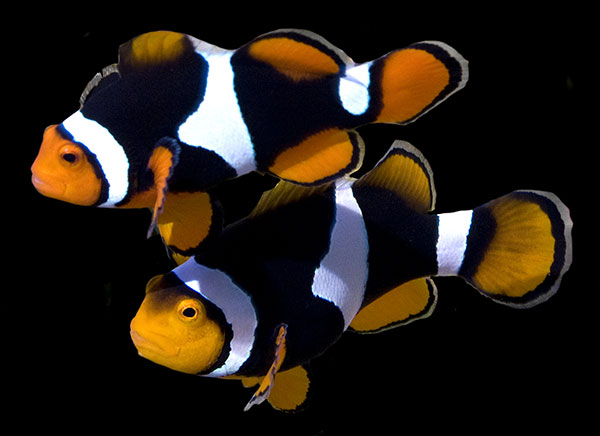
Amphiprion percula, at the heart of a proposed ESA listing but a captive-bred staple of the marine aquarium trade.
Why, during the past 18 years, hasn’t anyone proposed that the Redtailed Black Shark be listed under the Endangered Species Act?
The thought exercise around that question reveals the actual nature of the current ESA petitions that the aquarium trade has to keep an eye on.
The discrepancy reveals the brandishing of the Endangered Species Act as a back-door means of pushing a conservation agenda, particularly as it relates to climate change. On the one had, I admire the ingenuity of groups who look for unique ways to push our government to acknowledge a scientifically-documented and proven issue that seems to be completely ignored. But at the same time, I admire the ingenuity of these efforts in the same way I might be amused with the inventiveness of the latest rootkit computer virus. In other words, amazing creativity, provided you separate that from the actual devastating consequences that result.
Captive Breeding & Aquaculture: Collateral Victims?
As an aquarist, I’m terribly worried that we will become the collateral damage in this war, and with no real exceptions for aquaculture and commercial trade of ESA “Endangered Species,” the impact could be immense considering the ubiquity of some proposed species. For those ESA proposals that are actually aiming to curtail trade in a species due to perceived trade problems, I’m even more concerned, because CITES is the appropriate place to deal with international trade-related issues. I’ve said it privately before, I believe the ESA wasn’t meant to reach out to every corner of the Planet, and while I firmly believe in the good it can do, it does require modernization to recognize the reality of captive breeding and propagation.
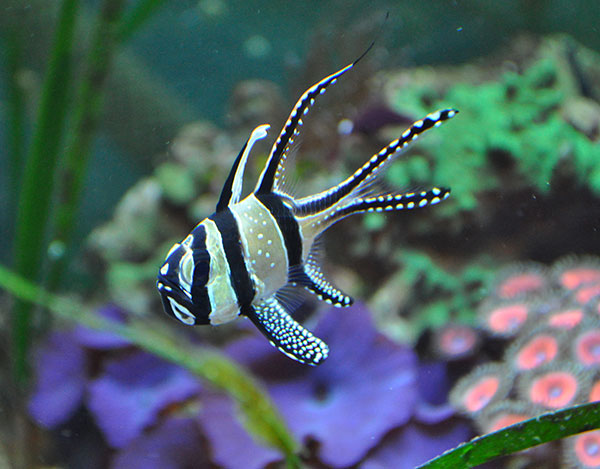
The Banggai Cardinalfish, Pterapogon kauderni, does have a deplorable track record with the aquarium trade, but it seems efforts are already underway to finally rectify those past mistakes.
I find proposals to list some of these corals and marine animals very troubling, because just like the Redtailed Shark, the Orange or Percula clownfish (A. percula) is subject to “massive commercial scale aquaculture production,” practically being the Guppy of the marine aquarium trade (the closely related A. ocellaris probably best deserves that title).
Recently (in the last 12-24 months) there has been an outright flood of aquacultured Banggai Cardinalfish entering the US market from Asia, so much so that retail prices have fallen to levels that directly compete with, or even undercut, wild fish, but by the same token, these retail prices have made it unprofitable to produce Banggais as a business for most US-based facilities.
These animals, the Percula Clownfish and Banggai Cardinalfish, are both subjects of pending ESA proposals, and yet the Redtailed Black Shark, an animal extinct, or nearly so, officially for 18 years, just trucks along, no ESA listing, no CITES regulations.
Clearly, the ESA and CITES are not being applied as they were really intended.
The IUCN’s Changing Story of the Redtailed Shark
I found it interesting that in the older “extinct in the wild” listings for the Redtailed Black Shark, I recalled IUCN pointing the blame at habitat manipulation. Pulling up the data via Archive.org, I was able to find a snapshot of the page from 2009. On that page, the plight of the Redtailed Shark was explained as follows:
“The reasons for the decline in the wild population of E. bicolor are not known. The aquarium fish trade has been accused of driving species to extinction because of very selective overfishing, but there is no documented evidence for this (Kottelat and Whitten 1996). Habitat modification may be the more likely cause of population declines in this case (M. Kottelat, pers. comm.). In the 1970s, many dams were constructed in Thailand and these probably severely impacted several large basins in the region. Large swamp areas have also been drained.” (1)
The current documentation reads differently, now offering a new “justification” subsection which reads:
“Historically it has been threatened by high levels of harvesting for the aquarium trade, but now this is supplied entirely by captive-bred individuals. Currently the major threat to the wild population is pollution from agricultural and domestic sources. More research is needed on this species’ presence across its range and a reintroduction programme is recommended.” (2)
And yet, on the current page, the same information which purports to refute claims of aquarium trade blame remains, reading:
“The reasons for the decline in the wild population of the species are not well known. The aquarium fish trade has been accused of driving the species to local extirpation because of very selective overfishing (over the past 40 years), but there is no documented evidence for this (Kottelat and Whitten 1996). Habitat modification may be the more likely cause of population declines in this case (M. Kottelat pers. comm. 2011). In the 1970s, many dams were constructed in Thailand and these probably severely impacted several large basins in the region. Large swamp areas have also been drained. Habitat degradation and change (including pollution from farmland and domestic sources, infrastructure development such as road building and dams causing loss of habitat and changing in flow regimes and siltation due to agriculture) are now the main threats to this species.” (2)
I believe that such a subtle attempt to shift blame between 2009 and 2014 is, sadly, representative of how the aquarium trade’s perception by the greater world is slowly changing, and arguably not for the better. It seems that even the IUCN is not immune to political leanings. Why else would you re-write history to include a unreferenced, unsubstantiated claim that the historical threat to the Redtailed Shark was the aquarium trade, even when you’ve already published cited evidence to the contrary?
Outwardly, on this matter, it would appear the IUCN is, at minimum, conflicted in its view of the situation. Or if you prefer my less unbiased opinion, this reads as a direct attempt to pin the blame on the aquarium trade with rampant disregard for what’s been reported and documented, seeing that no new information has been submitted to conflict the original assertions cited.
The Exciting “Rediscovery” of the Redtailed Shark
So now I get to what actually spurred this op-ed, a paper published this week heralding the “Rediscovery of the critically endangered cyprinid fish Epalzeorhynchos bicolor (Smith, 1931) from West Thailand (Cyprini-forms Cyprinidae)” (3). This is absolutely exciting news, as the IUCN’s listing of a small population in the Chao Phraya basin is cited as “the species is still extant (C. Vidthayanon pers. comm.)”, carries a little less weight than a formally published paper that we presume has passed scientific and academic rigor.
Indeed, the paper’s authors conclude that “the occurence of E. bicolor in the wild is certainly confirmed in Lower Maeklong Basin…whereas it is still unclear in the Chao Phraya Basin due to the lack, to date, of documented evidence”.
So at worst, we have a single fish found in a river by the paper’s authors; while interesting, the rediscovery of a single specimen in a historic range is certainly noteworthy, but it doesn’t really change anything.
At best, this discovery could hopefully represent the tip of the iceberg that represents a second population, however small, in addition to the one already reported from Chao Phraya. It could take a lot more searching to investigate that hypothesis.
Nathan Hill, in a Practical Fishkeeping blog post, perhaps tempered potential enthusiasm the best, when he wrote, “…it cannot be ascertained whether this was a relic from an old population, or whether it could be derived from reintroduction programs, or even accidental release by an aquarist.”
With the potential for one or two small remnant populations of a “extinct in the wild” species now being on the books in one form or another, can we really say there is “hope” for the species?
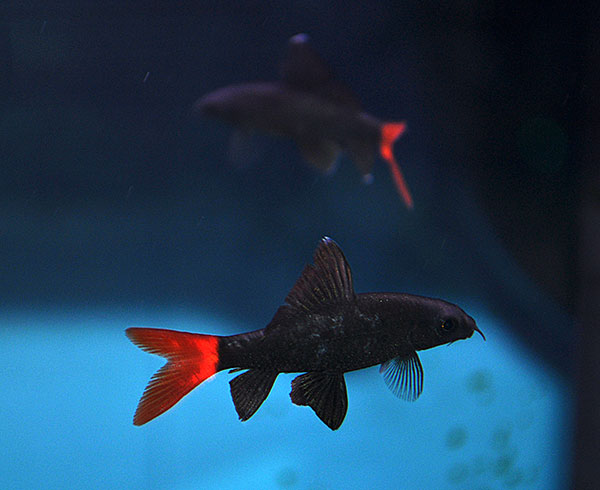
Look! I only had to drive 45 minutes from my home to find twice as many Red Tailed Sharks as researchers did! And I didn’t even have to kill them to photograph them to prove my amazing discovery! (Irony intentionally intended to emphasize my next point)
The Aquarium Ark
Yes, there is hope, but I believe that hope is mostly found within “The Aquarium Ark.” This is hardly the first time I’ve referenced my “Ark” concept, something that gets academics aflutter with worries of the “Ark” notion leading to hobbyists thinking they will be raising endangered species in their basements and reintroducing them to the wild. Well, perhaps, but that’s not really what the “Ark” concept is about.
No, it’s the likelihood that the largest known population of the critically endangered E. bicolor exists not in Chao Phraya, or the Lower Meakong Basin, but within the umbrella of the aquarium trade’s fish farms, wholesalers, retailers, and end consumers. A lot of people seem to wish this weren’t the case because it flies in the face of attempts to demonize the aquarium trade. Some may even go so far as to suggest this is simply not “species preservation” of any kind in an attempt to discount what is actually occurring!
It seems unsettling, particularly for those who are against aquarium keeping, that an “industrial ornamental fish farming machine” is the unwitting, and unintentional, main conservator of ex-situ populations of a critically endangered species. In other words, a real force for good in the battle to keep this endangered species around.
We have “arked” this species within the aquarium trade, we have kept it going, solely because people find the Redtailed Black Shark attractive and want to put one (or more) in their tanks. We vote with our wallets, through simple supply and demand, and many of us do so not even knowing that our actions are a positive vote for whether or not the Redtailed Shark, as a species, will persist or fade away.
The Reintroduction Dilemma
I doubt the fish farmers producing this species are thinking about reintroductions into the wild from captive populations. Some professionals are openly concerned about such proposals, so much so that the IUCN recommendation cite concern for the genetic suitability of captive stocks, stating that:
“[A species] recovery action plan and reintroductions (to extirpated locations) are recommended for this species. The species is widely commercially captive bred, but this stock may not be genetically suitable for re-introductions so a conservation specific ex-situ conservation breeding programme is recommended.” (2)
However, I propose that end use of the animals being produced probably has no bearing on the breeding principals put in place—the genetic rules of captive-species maintenance don’t necessarily change when you can’t go back to wild stock for “fresh blood.” In other words, if a fish farmer is smart enough to do what it takes to maintain a robust population of Redtail Sharks on his fish farm, that effort will require the same basic practices, and as a result will yield the same genetic diversity, that intentional ex-situ preservation efforts would require. This leads me to believe that concerns raised over genetic suitability are likely unfounded, and perhaps stem more from a potential anti-aquarium-trade bias that won’t allow authors and leaders to properly give credit where credit might be due.
Or I can even be really cynical and go so far as to suggest such sentiments against “aquarium-farmed fish”are borne out of some researchers’ own desires to see fellow researchers go into the wild, find the last few E. bicolor, scoop them up, put them in tanks, and “save the species” on their own, because that’s the only “proper way” to go about it. Meanwhile we continuously stock endless numbers of private and governmentally farmed fish into wild streams, lakes and rivers here in the US alone. These stories—that reintroduction of fish species is not likely to work—just aren’t adding up. You can’t have it both ways.
Regardless of these potentially esoteric or academic discussions, ultimately, were it not for home aquarists who buy this species as aquacultured livestock, very few “average” people would probably care whether E. bicolor was present, or exterminated, from Thailand in the first place.
The aquarium trade is what exposes us to the species, and is the direct reason we now care about it, produce it, and find any interest whatsoever in a single animal being found where it hadn’t been seen in a real long time. To the rest of the world it’s an inconsequential black minnow with a red tail. The aquarium trade has probably already “saved” the species many times over, unintentionally, and without help from scientific direction or conservation efforts.
Undeserved Blame Overshadows Well-Deserved Recognition
From the oft-cited Kottelat and Whitten 1996:
“The aquarium fish trade has been accused of driving species to extinction because of very selective overfishing, but there is no documented evidence for this. Some species which have been the subject of an important trade have decreased significantly and have disappeared in part of their original range, but this has always been related to other causes (e.g. Botia sidthimunki in Thailand). Some species have disappeared also in areas where they had never been collected for the aquarium trade (e.g. the ‘silver shark’ Balantiocheilos melanopterus in the Kapuas basin, west Borneo). On the other hand, some species may be temporarily saved from extinction because of the trade; for example, it is not clear whether the ‘red−tailed shark’ Epalzeorhynchos bicolor (commonly called Labeo bicolor ) still exists in the wild, but tens of thousands of specimens are exported annually from Thailand, all now captive bred.” (4)
There are those who will still attempt to pin this same industry with the blame for the wild population’s demise, even though there is no evidence. Nevermind that the species has probably had at least 18-20 years in the wild with little or no impact from the aquarium trade. (This week’s “Rediscovery” paper suggests Redtailed Black Sharks haven’t been seen in the wild for as long as 50+ years now, so perhaps wild trade ended a long time prior to 1996).
With all fish coming from commercial production, and no wild harvest of the species for the aquarium trade for decades, the Redtailed Black Shark has not rebounded in the way one might expect a highly fecund animal to recover once harvest pressures have been eliminated. I can acknowledge that it is certainly possible that the aquarium trade was responsible, this isn’t the first time such allegations have been levied, but it seems that all the evidence and logical extrapolations point in a different direction in this case.
I’m not naive enough to believe the aquarium trade is without sin; cyanide collection of marine fish is a stunning example of how badly individual parties and even whole communities of fishermen can behave even today. However, more worrisome to me is that the actual sins are not corrected, and with perceived sins and false blame being added to the general perceptions of the aquarium trade, this great capacity for the hobby and industry to function as the safety net, the last hope, for thousands of fish species, will be erased.
Meanwhile the Redtailed Black Sharks live on, struggling for a finhold in the wild, but thriving in the aquarium trade. While I am powerless to do anything about this species in Thailand’s rivers, I’d like to make sure that our “Aquarium Ark” keeps chugging along.
Image Credits: Matt Pedersen
About the Author: Matt Pedersen is a senior editor with Reef to Rainforest Media, publishers of AMAZONAS and CORAL Magazines. He breeds both freshwater and marine fishes, and his success with rare species helped earn him the coveted 2009 Aquarist of the Year Award from MASNA (Marine Aquarium Societies of North America). He lives in Duluth, Minnesota with his wife, Renee and two children.
Selected References
1. Kottelat, M. 1996. Epalzeorhynchos bicolor. In: IUCN 2009. IUCN Red List of Threatened Species. Version 2009.1. <www.iucnredlist.org>. Downloaded on 30 August 2009.
2. Vidthayanon, C. 2013. Epalzeorhynchos bicolor. The IUCN Red List of Threatened Species. Version 2014.2. <www.iucnredlist.org>. Downloaded on 01 August 2014.
Link to the live, updating IUCN Red List page for E. bicolor – http://www.iucnredlist.org/details/7807/0
3. Rediscovery of the critically endangered cyprinid fish Epalzeorhynchos bicolor (Smith, 1931) from West Thailand (Cyprini- formes Cyprinidae). Sitthi Kulabtong, Siriwan Suksri, Chirachai Nonpayom & Yananan Soonthornkit. Biodiversity Journal, 2014, 5 (2): 371–373
4. Kottelat M. & Whitten T., 1996. Freshwater biodiversity in Asia, with special reference to fish. World Bank Technical Paper, 343: 1–59
Updated 8/5/2014 for punctuation, clarification

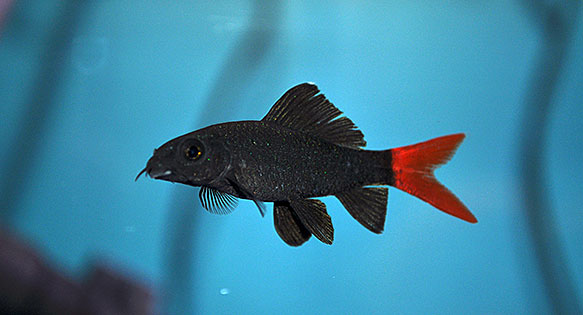
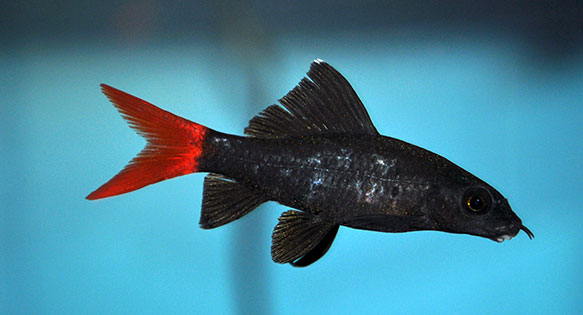





I too have been involved the aquarium fish trade since the late 70’s..I had absolutely no idea this taxa was even remotely in peril..Unreal! Great article..Thanx.
Really good op-ed. A firmament of what I have wondered about with many species out wild and captive. I know I am not alone with this. The african cichlids breeding in my spouses fish tank remind me that invasive tilapia displace wild oness every day.
I also want to see or hear of sustainable wild bred live caught for the hobby trade fisheries. The local people sustaining wild habitat and using it for profit with vested interest.
I have a single specimen of a Redtailed Black Shark, kept as the only fish in a 75-gallon aquarium, where it is thriving. Another irony about this species is, although they are beautiful and have interesting personalities, they are bullies when kept with other fish, often chasing tank mates to death. Yet they are bred and sold as peaceful community tank additions.